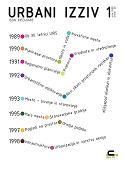Disabled people and accessibility: How successful is Slovenia in the elimination and prevention of built-environment and communication barriers?
Disabled people and accessibility: How successful is Slovenia in the elimination and prevention of built-environment and communication barriers?
Author(s): Boštjan Kerbler, Richard SendiSubject(s): Social Sciences
Published by: Urbanistični inštitut Republike Slovenije
Keywords: disable persons; built-environment barriers; communication barriers; barrier-free movement; accessibility; prevention and removal of barriers
Summary/Abstract: The Urban Planning Institute of the Republic of Slovenia and the Institute of the Republic of Slovenia for Social Protection, together conducted a research project entitled Measures for the realisation of the rights of the disabled to barrier-free access which was concluded in December 2008. The research was funded jointly by the Slovenian Research Agency and the Ministry of Labour, Family and Social Affairs. The main aim of the research was to conduct an extensive analysis of the state of care for persons with disabilities in Slovenia. This involved analysing the accessibility of the built environment and accessibility of communication and information, as well as investigating the efficiency of implementation of the policies and measures that were adopted at the national level for guaranteeing disabled persons barrier-free movement and social inclusion. The main part of the research is constituted of two field surveys, one conducted among individual disabled persons and the other conducted among the major disabled people’s organisation in Slovenia. On the basis of a preliminary literature review and a review of the current legislation and policies concerning the disabled, the guiding hypothesis for the survey was that very little has been done, so far, towards the realisation of the rights of the disabled which are declared in the various national documents. The results of the empirical research provide evidence in support of this hypothesis. In this paper, we present the results of both field surveys, give a summary of the major findings and, in conclusion, suggest some measures that need to be implemented in order to ensure greater efficiency of the realisation of the rights of the disabled to barrier-free access.
Journal: Urbani izziv
- Issue Year: 20/2009
- Issue No: 1
- Page Range: 123-140
- Page Count: 18
- Language: English

